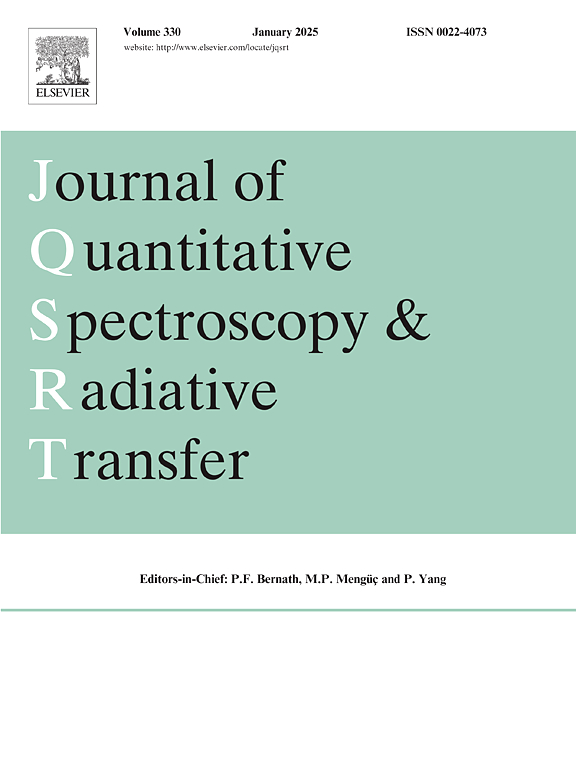异丁腈和氰基丙炔的近红外和中红外光谱:用于天体物理天体定量探测的吸收截面
IF 2.3
3区 物理与天体物理
Q2 OPTICS
Journal of Quantitative Spectroscopy & Radiative Transfer
Pub Date : 2025-04-04
DOI:10.1016/j.jqsrt.2025.109466
引用次数: 0
摘要
导出了两种非环有机分子氰丙炔(CH3C3N)和异丁腈(i-C3H7CN)的室温吸收截面,并为2024年高分辨率透射分子吸收数据库(HITRAN)的更新提供了依据。用红外傅立叶变换光谱仪记录了纯氰丙炔和异丁腈在室温范围为160 ~ 3500 cm-1(3-60µm)的气相红外光谱。光谱分辨率选择为0.056 cm-1。对于18-20µm光谱区域,使用的额外分辨率为0.01 cm-1。在观测到的各种吸收波段中,其中一些,如约500 cm-1 (20 μ m)的氰丙烯ν10波段,对于探测和量化天体物理对象中的这些分子特别有趣。作为第一个应用,回收的吸收截面已用于辐射传输代码,以模拟使用莫纳克亚天文台红外望远镜设施(IRTF)的德克萨斯梯队交叉梯队光谱仪(TEXES)获得的土卫六平流层观测结果。讨论了土卫六平流层中氰丙烯和异丁腈的上限分别为3 × 10-9和3 × 10-7。本文章由计算机程序翻译,如有差异,请以英文原文为准。
Near- and mid-infrared spectroscopy of isobutyronitrile and cyanopropyne: absorption cross-sections for quantitative detection in astrophysical objects
Absorption cross-sections at room temperature have been derived for two non-cyclic organic molecules cyanopropyne (CH3C3N) and isobutyronitrile (i-C3H7CN), and have been proposed for the 2024 update of the high-resolution transmission molecular absorption database (HITRAN). The gas phase infrared spectra of pure cyanopropyne and isobutyronitrile have been recorded at room temperature between 160 and 3500 cm-1 (3–60 µm) using an infrared Fourier transform spectrometer. The spectral resolution has been chosen equal to 0.056 cm-1. For the 18–20 µm spectral region an additional resolution equal to 0.01 cm-1 has been used. Among the various absorption bands observed, some of them, as the ν10 band of cyanopropyne around 500 cm-1 (20 µm), are particularly interesting for detecting and quantifying these molecules in astrophysical objects. As a first application, the retrieved absorption cross-sections have been used in a radiative transfer code to simulate observations of Titan's stratosphere acquired using the Texas Echelon Cross Echelle Spectrograph (TEXES at the Infrared Telescope Facility (IRTF, Mauna Kea Observatory). We discuss preliminary results and perspectives, among which estimated upper limits of 3 × 10–9 for cyanopropyne and 3 × 10–7 for isobutyronitrile in Titan's stratosphere.
求助全文
通过发布文献求助,成功后即可免费获取论文全文。
去求助
来源期刊
CiteScore
5.30
自引率
21.70%
发文量
273
审稿时长
58 days
期刊介绍:
Papers with the following subject areas are suitable for publication in the Journal of Quantitative Spectroscopy and Radiative Transfer:
- Theoretical and experimental aspects of the spectra of atoms, molecules, ions, and plasmas.
- Spectral lineshape studies including models and computational algorithms.
- Atmospheric spectroscopy.
- Theoretical and experimental aspects of light scattering.
- Application of light scattering in particle characterization and remote sensing.
- Application of light scattering in biological sciences and medicine.
- Radiative transfer in absorbing, emitting, and scattering media.
- Radiative transfer in stochastic media.

 求助内容:
求助内容: 应助结果提醒方式:
应助结果提醒方式:


